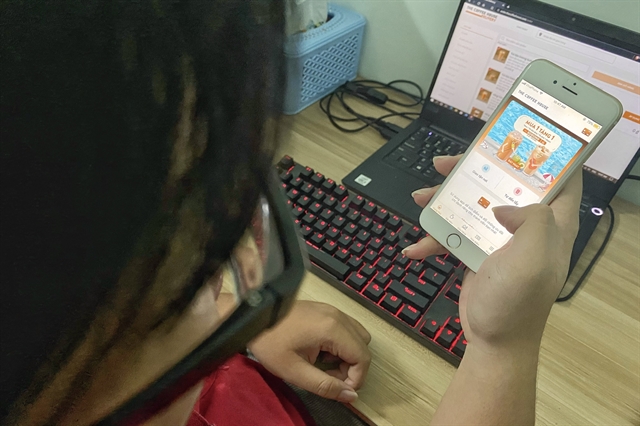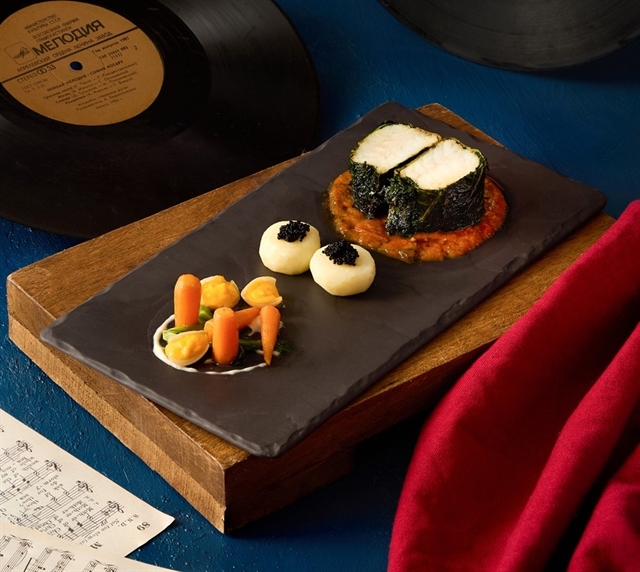 Economy
Economy

The online food delivery market has seen robust growth since the COVID-19 outbreak began, and this is likely to continue through this year given Vietnamese consumers’ cautiousness, Peter Christou, commercial director of Kantar Worldpanel Vietnam, has said.

|
| Drivers collect delivery orders in Tân Phú District, HCM City. – VNS Photo Diệp Phan |
HCM CITY – The online food delivery market has seen robust growth since the COVID-19 outbreak began, and this is likely to continue through this year given Vietnamese consumers’ cautiousness, Peter Christou, commercial director of Kantar Worldpanel Vietnam, has said.
There was rapid adoption of online food delivery by consumers, food and beverage businesses and delivery services, and Christou noted that early signs indicate this habit would stick since the spending remained consistent even when restrictions were eased and out-of-home spending recovered as restaurants reopened.
Food and beverage outlets in HCM City have switched to takeaway and delivery services during the two-week social distancing that began on Monday last week.
Coffee chains such as The Coffee House, Trung Nguyên, and Cheese Coffee, and fast food chains Lotteria and KFC have their own online ordering app now and also use food delivery partners like Grab, Now and Baemin.
Trương Hàm Liêm, marketing director of Lotteria Việt Nam, said online sales have doubled during social distancing, and account for 40 per cent of total revenues, with the remaining being through delivery partners and from takeaways.
There has been a reduction in the number of online orders, but the value of each order has increased as customers now tend to order in groups, he said.
Hoàng Văn Lộc, owner of a milk tea shop in Bình Tân District, told Việt Nam News: "Our revenue has fallen by 50 per cent these days, so we have to offer discounts and find new customers by promoting sales on social networks to keep the business going.”

|
| The Coffee House gets 50 per cent of all orders through its own app. – VNS Photo Diệp Phan |
Many restaurants are also tying up with ordering platforms.
Nguyễn Hạnh, owner of an eatery in District 10, said: “We have been selling our products on Now and GrabFood for nearly two years, and they have increased our number of orders sharply. We used to have our own delivery service but only for orders over VNĐ200,000 (US$8.71) within five kilometres.
“Now, with these platforms, customers from anywhere in the city can have a taste of our noodles, costing around VNĐ50,000 ($2.18) a bowl, delivered to them at a reasonable fee.
“We can also buy discount coupons, which are partly supported by the platforms, for customers to use or pay to feature on their banners to attract more customers.”
Hoàng Anh, who started selling food on Baemin since the COVID outbreak began last year, said: “Ordering platforms have made tracking orders much easier and improved our revenues. Commissions are rather high but manageable. So we will continue to use the apps in the post-pandemic future.”
Forty-three per cent of HCM City’s population ordered food online at least once a week in 2020, and 34 per cent in Hà Nội, according to Kantar.
Thùy Hương, who orders food through delivery apps two to four times a week, started last year.
She told Việt Nam News: “Their convenience has made me stay. I no longer have to worry about long queues or the weather when I am hungry.”
Lan Ngọc, a final-year student at the HCM City University of Law, said: “I have been using delivery apps at least once a week since 2019. The apps allow me to compare the menus and prices of various restaurants, which could be troublesome in the past. They also offer plenty of promotions and choices of foods.”

|
| No Title |
Realising its vast potential, investors have started to cash in on this market segment. Recently Loship announced investment by Skype co-founder Jaan Tallinn through his investment vehicle, MetaPlanet Holdings.
The online food delivery market would remain competitive for at least the next two or three years, Loship CEO Nguyễn Hoàng Trung told Vietnam Investment Review.
Việt Nam has many favourable conditions for food delivery, including a vast market, substantial user base, high internet and mobile penetration rates, and more, and so attracts many players, he pointed out.
“Simplified e-banking systems and improved food-service logistics coupled with changing customer lifestyles are also propelling the growth of the food delivery market.
“The pandemic has necessitated the act of home delivery, which drives growth even further.”
GrabFood saw the number of merchant partners grow three-fold between the first and third quarters of 2020, while the average order value was up 26 per cent.
GoBiz, a special application for GoFood (Gojek) partners, has helped reduce the time it takes for food to travel between restaurant and customer by up to 50 per cent and the number of its completed orders has increased by 300 per cent.
Other players in the market have also stepped up their game. Baemin recently launched in Đà Nẵng, marking its expansion into the central region. Foody’s Now is diversifying its delivery services from food and medicines to flowers to compete with other rivals.
A survey by Q&Me found that GrabFood and Now are the most popular delivery apps, with Baemin and GoFood close behind and the former growing at the fastest rate.
“The competition will be fiercer than ever and the winners will be those who embrace partnerships and deliver excellent customer experiences,” Christou said, pointing out that the biggest challenge for online food delivery platforms is attracting investors to achieve expansion.
The value of Việt Nam’s digital economy, including e-commerce and food delivery, grew by 16 per cent to $14 billion in 2020, according to the eConomy SEA 2020 report.
Digitising and personalising the service experience has become a matter of survival for providers, according to financial consultancy firm Deloitte.
Convenience, speed and competitive prices are the top factors in consumer choice decisions. – VNS




